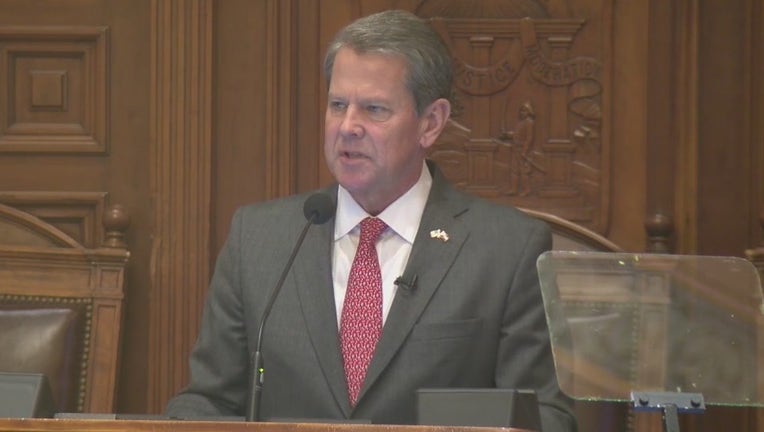Georgia government pocketing another $5B budget surplus

Georgia Governor Brian Kemp delivered the State of the State address on Jan. 13, 2022.
ATLANTA - Georgia will collect another $5 billion in surplus revenue after the just-concluded budget year, which could leave lawmakers and Gov. Brian Kemp with more than $10 billion in extra cash to spend, invest or give back to taxpayers. That’s about $1,000 for every Georgia resident.
Final numbers for the 2023 budget year that ended June 30 won’t be clear for weeks. But numbers announced Wednesday by the state Revenue Department show taxes collected by that department matched last year’s $33 billion, while the Republican Kemp had estimated a $5.4 billion decrease.
It’s the third year of huge surpluses, after $3.7 billion in 2021 and $6.4 billion in 2022, and critics say Republicans are purposefully holding down spending while cutting university budgets, refusing to fully expand Medicaid health insurance to poorer adults and watching state employees flee.
Danny Kanso, senior fiscal analyst with the liberal-leaning Georgia Budget & Policy Institute, said leaders "are actively choosing to leave billions on the table to accrue increasingly large reserves for no clear purpose."
The gusher of revenue, which started during the pandemic, continued in the 2023 budget year thanks to big boosts in corporate income tax collections and sales tax collections, even as personal income taxes fell.
Overall tax collections have cooled in recent months — they were down 0.4% in June compared to the same month in 2022. But the state would have to see a disastrous $5 billion drop in tax revenues in the 2024 budget year, which began July 1, to not meet needed projections for the current year. That means Georgia is likely to run a fourth year of surpluses, unless Kemp and lawmakers substantially increase spending or cut taxes.

Georgia House passes amended budget with cash for tax breaks
Good news for Georgians as more money could soon be in their pocket. The Georgia House approved money for a $1 billion property tax break and a $1 billion income tax break.
"The governor looks forward to working closely with the General Assembly on priorities for how the state’s one-time funds will be used in a strategic, fiscally responsible way that does not commit short-term revenue gains to long-term obligations," spokesperson Andrew Isenhour said in a statement.
But after three years of big surpluses, it’s far from clear that the revenue bump is a short-term gain. Democrat Stacey Abrams proposed in her campaign last year to spend some of the surplus to launch new programs. But with Kemp winning another term, he has cracked the state’s purse only a little. The governor by law sets a ceiling on how much lawmakers can spend.
Sen. Nan Orrock, an Atlanta Democrat, said too many state services are "on a starvation diet" and that it’s time for Kemp to increase spending.
"He’s been very off on revenue projections, and it’s time to break with the building up a cash surplus and hoarding," Orrock said. "It’s time to come to the table with a plan to fund the services Georgians are crying out for."
But Republican Lt. Gov Burt Jones said the state should pursue his goal of gradually eliminating Georgia’s income tax.
"It’s time to look at ways to cut the state income tax and return more money back to Georgia families while continuing to balance our budget and remain fiscally responsible," Jones said in a statement.
Kemp dipped into the surplus this year for a second $1 billion round of state income tax rebates, giving taxpayers between $250 and $500 back. But a property tax rebate program, giving the typical homeowner about $500, was paid for inside the budget, spending some of the state’s increased revenue.
Lawmakers amended the budget that ended June 30 to boost spending by $2.4 billion, although revenue would have allowed for much higher outlays. Including federal money, lottery proceeds, and other fees and taxes state agencies collect, total spending was budgeted at $61.6 billion.
Beyond the unallocated surplus, Georgia also has a rainy day fund of $5.2 billion. By law, it contains up to 15% of tax collections from the previous year, set aside for budget shortfalls or other crises. Because state tax collections were flat, the rainy day fund should stay basically level.
Isenhour said some of the money will be needed for a midyear adjustment for K-12 schools, which cost $350 million. He said Kemp also plans to ask lawmakers in January to spend more in the current budget to cover costs that have risen because of inflation.
Georgia’s budget pays to educate 1.7 million K-12 students and 435,000 college students, house 47,000 state prisoners, pave 18,000 miles (29,000 kilometers) of highways and care for more than 200,000 people who are mentally ill, developmentally disabled, or addicted to drugs or alcohol.

